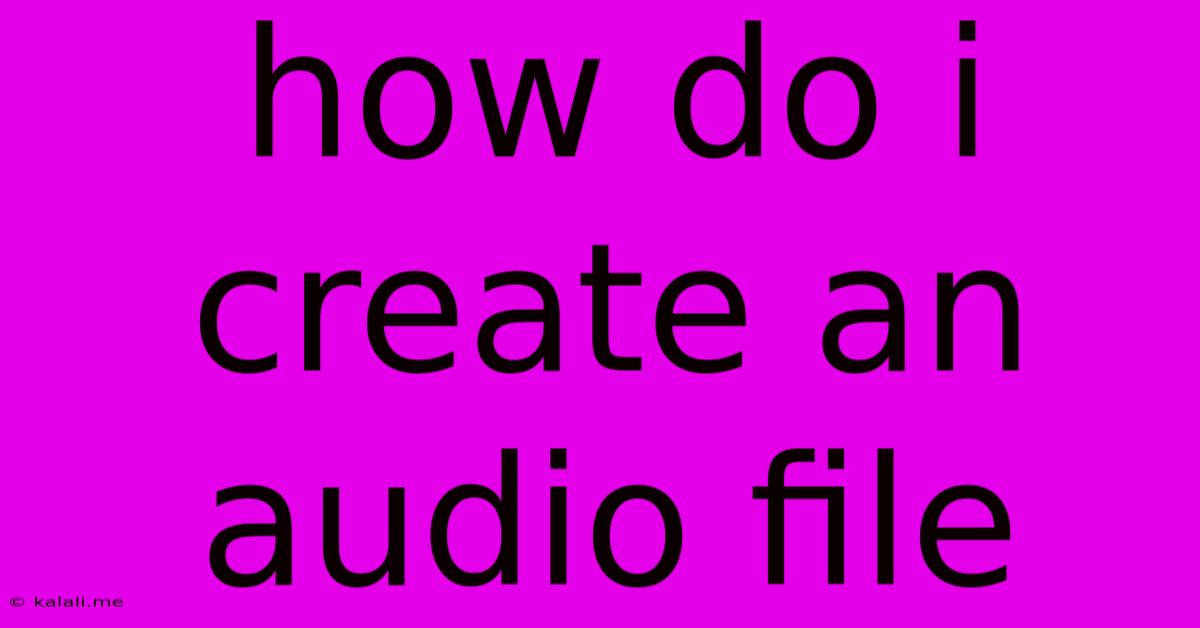How Do I Create An Audio File
Kalali
Jun 09, 2025 · 3 min read

Table of Contents
How Do I Create an Audio File? A Comprehensive Guide
Creating an audio file is easier than you might think! Whether you're recording a podcast, composing music, or simply capturing a voice memo, this guide will walk you through the process using various methods and tools, covering everything from basic recording to advanced audio editing. This article covers the different software options available, hardware needs, and tips for achieving professional-sounding results.
Choosing Your Recording Method: Hardware and Software
The first step is determining the type of audio you want to create and the tools you need to capture it. This largely depends on your budget and technical expertise.
1. Using Your Smartphone:
- Pros: Convenient, readily accessible, often has built-in editing features.
- Cons: Limited audio quality, potentially noisy recordings, fewer editing options compared to dedicated software.
- How-to: Most smartphones have a built-in voice recorder app. Simply open the app, press record, and start speaking or playing your instrument. After recording, save the file (usually as an MP3 or WAV).
2. Using a Computer with a Microphone:
- Pros: Higher audio quality, more advanced editing capabilities, greater control over recording settings.
- Cons: Requires a computer and microphone, learning curve for using audio editing software.
- How-to: You'll need a microphone (USB microphones are easiest to connect) and audio recording software. Popular free options include Audacity and GarageBand (Mac). Paid options offer more advanced features. Connect the microphone, open the software, and hit record.
3. Using Professional Recording Equipment:
- Pros: Highest audio quality, professional-level control, suitable for complex projects.
- Cons: Expensive investment, requires technical knowledge, space and setup considerations.
- How-to: This usually involves a digital audio workstation (DAW) like Pro Tools, Logic Pro X, or Ableton Live, a high-quality microphone, audio interface, and possibly additional equipment like mixing boards and studio monitors. The process is more involved and often requires training or experience.
Choosing the Right Software: A Quick Comparison
There's a vast array of audio recording and editing software available, ranging from simple voice recorders to powerful digital audio workstations (DAWs). Here's a brief comparison to help you choose:
| Software | Type | Cost | Features | Best For |
|---|---|---|---|---|
| Audacity | DAW | Free | Basic recording & editing, cross-platform | Beginners, basic recording & editing tasks |
| GarageBand | DAW | Free (Mac) | User-friendly, decent features | Beginners, podcasting, music creation (Mac) |
| Reaper | DAW | Paid | Powerful, customizable, very versatile | Intermediate to advanced users, professional work |
| Logic Pro X | DAW | Paid (Mac) | Professional-grade, extensive features | Music production, advanced audio editing (Mac) |
| Pro Tools | DAW | Paid | Industry standard, powerful, extensive features | Professional audio production |
Essential Tips for High-Quality Audio
Regardless of the method you choose, here are some tips for obtaining professional-quality audio files:
- Minimize Background Noise: Record in a quiet environment.
- Proper Microphone Placement: Position your microphone appropriately for the best sound quality. Experiment with distance and angles.
- Monitor Your Levels: Avoid clipping (distortion caused by too-high levels).
- Use Headphones: This prevents feedback loops and lets you hear your recording clearly.
- Edit Your Audio: Use software to clean up unwanted noise, adjust levels, and improve clarity.
File Formats Explained
Once you've recorded your audio, you'll need to save it. Understanding different file formats is important:
- WAV: Uncompressed, high-quality audio, large file size.
- MP3: Compressed, smaller file size, good quality.
- AAC: Compressed, smaller file size than MP3, good quality.
- AIFF: Uncompressed, high-quality audio, popular on macOS.
The best format depends on your needs. For high-quality archiving, WAV or AIFF are best. For sharing online, MP3 or AAC are more practical due to their smaller file sizes.
Creating an audio file is a straightforward process once you understand the basics. By selecting the appropriate hardware and software, and following the tips outlined above, you can create high-quality audio files for any purpose. Remember to experiment and find the workflow that best suits your needs and preferences.
Latest Posts
Latest Posts
-
How To Fix A Leaking Gas Tank
Jun 09, 2025
-
Shorten A Title In Chicago Manual Of Style
Jun 09, 2025
-
Can Refractive Index Be Less Than One
Jun 09, 2025
-
Set Audit Fields Upon Record Creation
Jun 09, 2025
-
Size Of The Moon Compared To The Sun
Jun 09, 2025
Related Post
Thank you for visiting our website which covers about How Do I Create An Audio File . We hope the information provided has been useful to you. Feel free to contact us if you have any questions or need further assistance. See you next time and don't miss to bookmark.